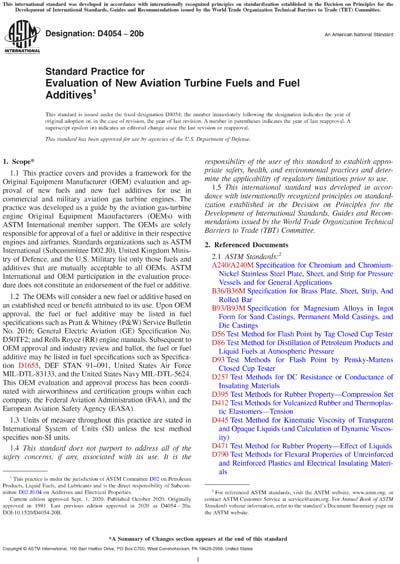Historical
ASTM D4054-20b
Standard Practice for Evaluation of New Aviation Turbine Fuels and Fuel Additives
1.1 This practice covers and provides a framework for the Original Equipment Manufacturer (OEM) evaluation and approval of new fuels and new fuel additives for use in commercial and military aviation gas turbine engines. The practice was developed as a guide by the aviation gas-turbine engine Original Equipment Manufacturers (OEMs) with ASTM International member support. The OEMs are solely responsible for approval of a fuel or additive in their respective engines and airframes. Standards organizations such as ASTM International (Subcommittee D02.J0), United Kingdom Ministry of Defence, and the U.S. Military list only those fuels and additives that are mutually acceptable to all OEMs. ASTM International and OEM participation in the evaluation procedure does not constitute an endorsement of the fuel or additive.
1.2 The OEMs will consider a new fuel or additive based on an established need or benefit attributed to its use. Upon OEM approval, the fuel or fuel additive may be listed in fuel specifications such as Pratt & Whitney (P&W) Service Bulletin No. 2016; General Electric Aviation (GE) Specification No. D50TF2; and Rolls Royce (RR) engine manuals. Subsequent to OEM approval and industry review and ballot, the fuel or fuel additive may be listed in fuel specifications such as Specification D1655, DEF STAN 91–091, United States Air Force MIL-DTL-83133, and the United States Navy MIL-DTL-5624. This OEM evaluation and approval process has been coordinated with airworthiness and certification groups within each company, the Federal Aviation Administration (FAA), and the European Aviation Safety Agency (EASA).
1.3 Units of measure throughout this practice are stated in International System of Units (SI) unless the test method specifies non-SI units.
1.4 This standard does not purport to address all of the safety concerns, if any, associated with its use. It is the responsibility of the user of this standard to establish appropriate safety, health, and environmental practices and determine the applicability of regulatory limitations prior to use.
1.5 This international standard was developed in accordance with internationally recognized principles on standardization established in the Decision on Principles for the Development of International Standards, Guides and Recommendations issued by the World Trade Organization Technical Barriers to Trade (TBT) Committee.
Content Provider
ASTM International [astm]






